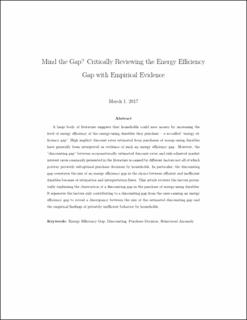Please use this identifier to cite or link to this item:
https://doi.org/10.21256/zhaw-20977Full metadata record
| DC Field | Value | Language |
|---|---|---|
| dc.contributor.author | Stadelmann, Marcel | - |
| dc.date.accessioned | 2020-12-03T11:07:47Z | - |
| dc.date.available | 2020-12-03T11:07:47Z | - |
| dc.date.issued | 2017-03-22 | - |
| dc.identifier.issn | 2214-6296 | de_CH |
| dc.identifier.issn | 2214-6326 | de_CH |
| dc.identifier.uri | https://digitalcollection.zhaw.ch/handle/11475/20977 | - |
| dc.description.abstract | A large body of literature suggests that households could save money by increasing the level of energy efficiency of the energy-using durables they purchase – a so-called “energy efficiency gap”. High implicit discount rates estimated from purchases of energy-using durables have generally been interpreted as evidence of such an energy efficiency gap. However, the “discounting gap” between econometrically estimated discount rates and risk-adjusted market interest rates commonly presented in the literature is caused by different factors not all of which portray privately suboptimal purchase decisions by households. In particular, the discounting gap overstates the size of an energy efficiency gap in the choice between efficient and inefficient durables because of estimation and interpretation flaws. This article reviews the factors potentially explaining the observation of a discounting gap in the purchase of energy-using durables. It separates the factors only contributing to a discounting gap from the ones causing an energy efficiency gap to reveal a discrepancy between the size of the estimated discounting gap and the empirical findings of privately inefficient behavior by households. | de_CH |
| dc.language.iso | en | de_CH |
| dc.publisher | Elsevier | de_CH |
| dc.relation.ispartof | Energy Research & Social Science | de_CH |
| dc.rights | Licence according to publishing contract | de_CH |
| dc.subject | Energy efficiency gap | de_CH |
| dc.subject | Discounting | de_CH |
| dc.subject | Purchase decision | de_CH |
| dc.subject | Behavioral anomaly | de_CH |
| dc.subject.ddc | 333.79: Energie | de_CH |
| dc.title | Mind the gap? : critically reviewing the energy efficiency gap with empirical evidence | de_CH |
| dc.type | Beitrag in wissenschaftlicher Zeitschrift | de_CH |
| dcterms.type | Text | de_CH |
| zhaw.departement | School of Management and Law | de_CH |
| dc.identifier.doi | 10.1016/j.erss.2017.03.006 | de_CH |
| dc.identifier.doi | 10.21256/zhaw-20977 | - |
| zhaw.funding.eu | Not specified | de_CH |
| zhaw.originated.zhaw | No | de_CH |
| zhaw.pages.end | 128 | de_CH |
| zhaw.pages.start | 117 | de_CH |
| zhaw.publication.status | acceptedVersion | de_CH |
| zhaw.volume | 27 | de_CH |
| zhaw.publication.review | Peer review (Publikation) | de_CH |
| zhaw.author.additional | No | de_CH |
| zhaw.display.portrait | Yes | de_CH |
| Appears in collections: | Publikationen School of Management and Law | |
Files in This Item:
| File | Description | Size | Format | |
|---|---|---|---|---|
| 2017_Stadelmann_Mind-the-Gap_Postprint.pdf | 341.15 kB | Adobe PDF |  View/Open |
Show simple item record
Stadelmann, M. (2017). Mind the gap? : critically reviewing the energy efficiency gap with empirical evidence. Energy Research & Social Science, 27, 117–128. https://doi.org/10.1016/j.erss.2017.03.006
Stadelmann, M. (2017) ‘Mind the gap? : critically reviewing the energy efficiency gap with empirical evidence’, Energy Research & Social Science, 27, pp. 117–128. Available at: https://doi.org/10.1016/j.erss.2017.03.006.
M. Stadelmann, “Mind the gap? : critically reviewing the energy efficiency gap with empirical evidence,” Energy Research & Social Science, vol. 27, pp. 117–128, Mar. 2017, doi: 10.1016/j.erss.2017.03.006.
STADELMANN, Marcel, 2017. Mind the gap? : critically reviewing the energy efficiency gap with empirical evidence. Energy Research & Social Science. 22 März 2017. Bd. 27, S. 117–128. DOI 10.1016/j.erss.2017.03.006
Stadelmann, Marcel. 2017. “Mind the Gap? : Critically Reviewing the Energy Efficiency Gap with Empirical Evidence.” Energy Research & Social Science 27 (March): 117–28. https://doi.org/10.1016/j.erss.2017.03.006.
Stadelmann, Marcel. “Mind the Gap? : Critically Reviewing the Energy Efficiency Gap with Empirical Evidence.” Energy Research & Social Science, vol. 27, Mar. 2017, pp. 117–28, https://doi.org/10.1016/j.erss.2017.03.006.
Items in DSpace are protected by copyright, with all rights reserved, unless otherwise indicated.